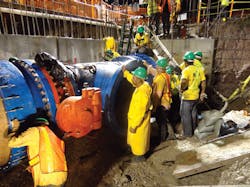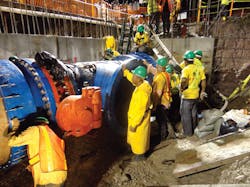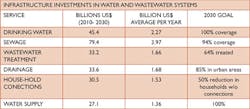Wastewater Challenges & Opportunities in Latin America
While Latin America is one of the world’s richest regions in water resources, approximately 37 million people don’t have access to safe supply of drinking water and nearly 110 million people don’t have sanitation facilities. Could the lifting of sanctions in Cuba help drive change in the region?
By Sofia Berger
Cuba is the new “it” nation in Latin America - and justifiably so. As years of sanctions end and icy political and business relationships thaw, the potential for a lucrative, tourism-driven economy on the island has caught the imagination of many worldwide. Within the engineering industry, there is also the buzz of possible opportunity.
After all, Cuba will need infrastructure upgrades in many areas including clean water and effective management of wastewater. Normalisation of relations with the US has sharpened the focus on Cuba as a country where wastewater solutions are essential.
Drinking water first, wastewater second
Historically, Latin America has stalled on wastewater infrastructure, preferring to prioritise providing residents with clean drinking water. And overall, according to the World Bank, the region has made significant strides in improving access to drinking water, although there’s still work to be done.
In 2015, for instance, the World Bank developed monitoring reports for its investments in Panama, El Salvador and Honduras. The reports highlight water and wastewater coverage for each country.
Latin America is one of the world’s richest regions in water resources. Sadly, though, approximately 37 million people don’t have access to safe supply of drinking water, and nearly 110 million people don’t have sanitation facilities. Haiti, Dominican Republic, Nicaragua, Ecuador, Peru and Bolivia are all countries where drinking water is less accessible, according to Wambui Gichuri, World Bank manager in water resources for Latin America.
Now experts and funders are increasingly turning their attention to wastewater treatment. Countries like Panama and Peru, which have already taken action to improve their water and wastewater infrastructure, are models for others in the region.
There is no “one-size-fits-all” water and wastewater treatment solution. That reality is a reflection of the age of the infrastructure, the size of the population using it, and the resources available to maintain it.
Still, it may come as a surprise that water and wastewater infrastructure the world over often share common challenges. In Latin America, as elsewhere, countries are experiencing significant water loss due to the deteriorated condition of distribution and transmission water mains and services. Accelerating rates of urbanization and, in the case of Cuba, an impending tourism boom have made wastewater infrastructure challenges particularly acute, prompting some countries to undertake ambitious efforts to address those challenges.
In Cuba, tourism is growing consistently with improvement of relations with the US. Since the start of 2016, one million people have visited the island, up nearly 15% from the same period last year.
Money Matters
Identifying the need for wastewater infrastructure upgrades is only part of the story. While the case for wastewater treatment infrastructure is clear, financing investments and building public support for such outlays is less so.
In Latin America, as elsewhere, governments have been the traditional funding source for wastewater infrastructure. Resource constraints and the scale of the needed investments have limited what governments can do. To close that gap, funding from development banks and multilateral lending institutions like the World Bank has become increasingly important across the region, especially as global commodities - a major income generator for some Latin American countries - have experienced steep price declines. Even provider fees can be funding sources, but on a much smaller scale, for wastewater projects in the region. Each country will approach the funding question based on its own context.
In Panama, funding is provided by both the government and development banks, and in Cuba, it’s expected that the government and also multilateral lending institutions and foreign development agencies will be the funding source for water and wastewater projects.
Interestingly, Peru has seen good results with public-private partnership funding models. There, potable water and wastewater infrastructure were both enhanced to benefit local, often underserved communities, where sanitary facilities had been lacking. Elsewhere in Latin America, such as Panama, policymakers and funders are making substantive investments in wastewater treatment and sanitation services, with a particular focus on traditionally underserved communities as part of initiatives like the Panama Bay and City Sanitation Project, the Water Supply Works-Group 2 Eastern Main, and the water and sanitation works in David, Chiriquí and Santiago de Veraguas areas.
Looking toward the future
The good news is that the improvement of US-Cuba relations may help spur interest in further wastewater infrastructure development throughout the rest of the region by showcasing how long-term investments today will pay dividends in terms of economic development, improved public health and less pollution.
To reap those dividends, several Latin American countries will require significant near-term investment.
Goal- and data-based international development initiatives, such as the UN’s sustainable development goals (SDGs), are also sharpening the focus on wastewater treatment efforts in the region. Besides the World Bank, the Inter-American Development Bank (IADB) and the Development Bank of Latin America (CAF) have become major investors in Latin America’s wastewater infrastructure, in alignment with their mission and the SDGs. For instance, IADB and CAF have mapped out their water and wastewater system investments between 2010 and 2030.
These wastewater treatment investments will involve outlays, but an ecosystem of new funders and funding approaches are now in place. Perhaps most important, given the recognition of the growing need for these investments, there’s an opportunity for greater public involvement and buy-in that gives these investments wider legitimacy and demonstrates how they’re geared to solve, affordably and effectively, Latin America’s wastewater needs.
Sofia Berger is vice president in charge of Latin American and Caribbean operations at Louis Berger.
More Water & WasteWater International Archives Issue Articles




